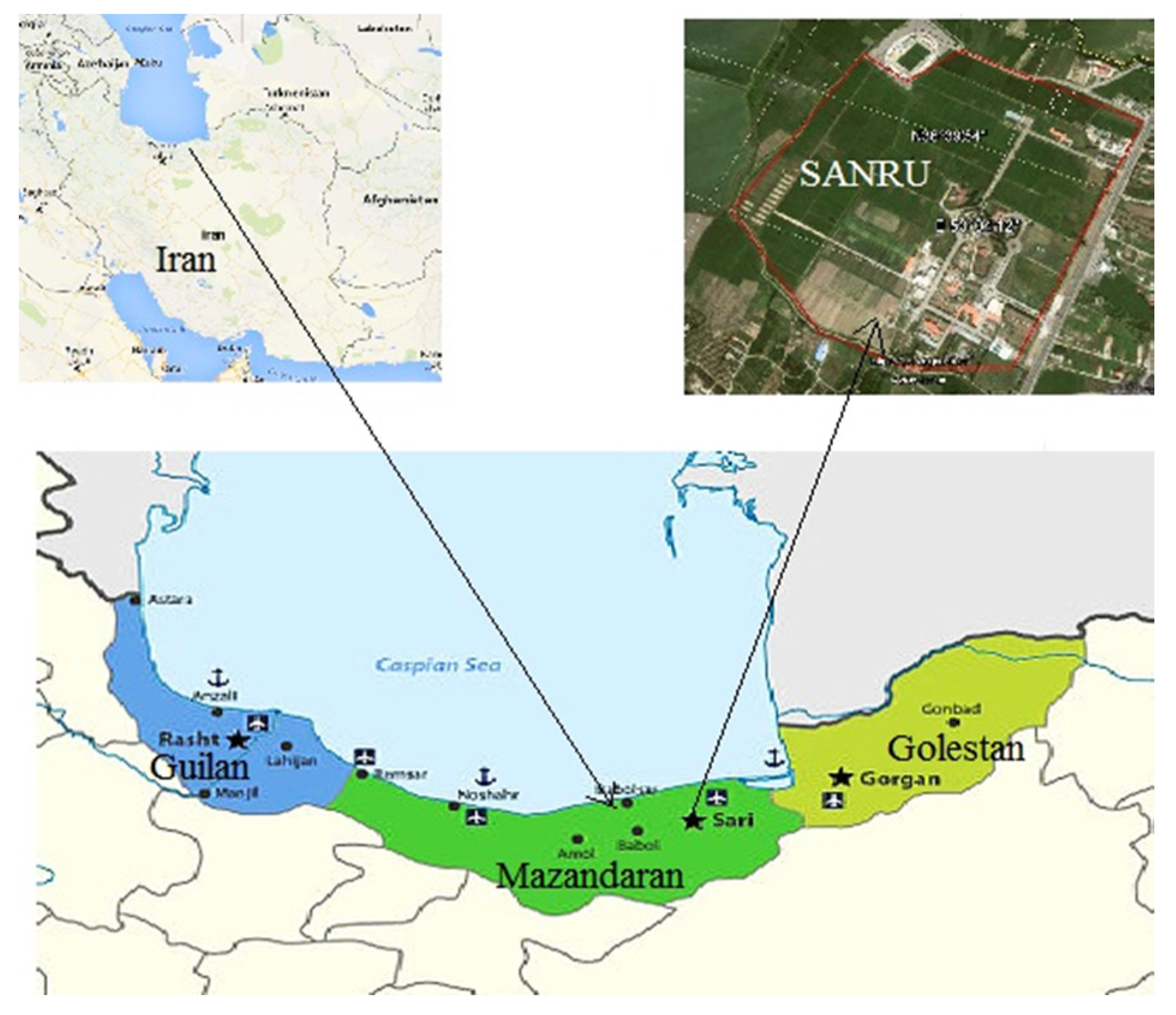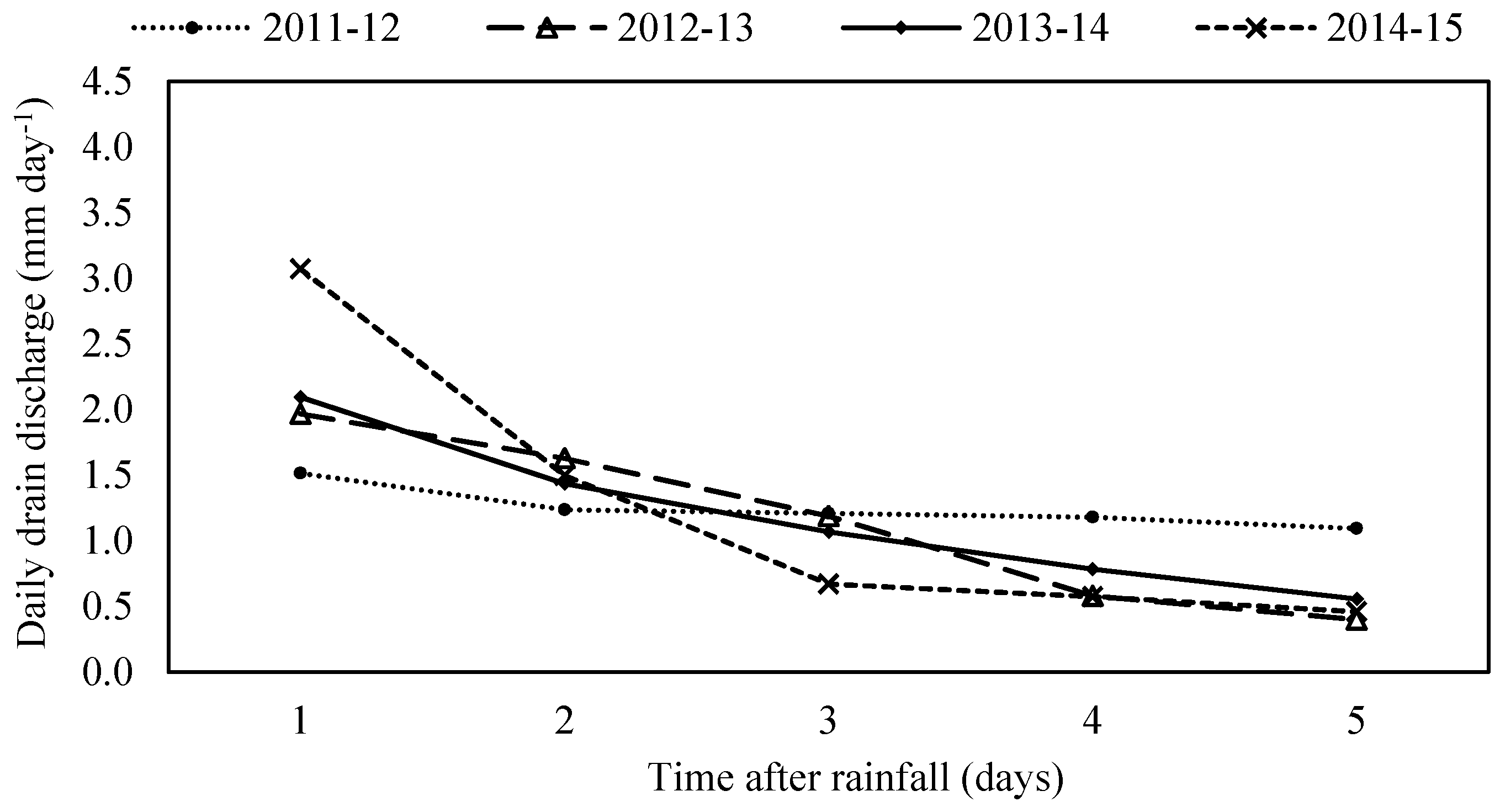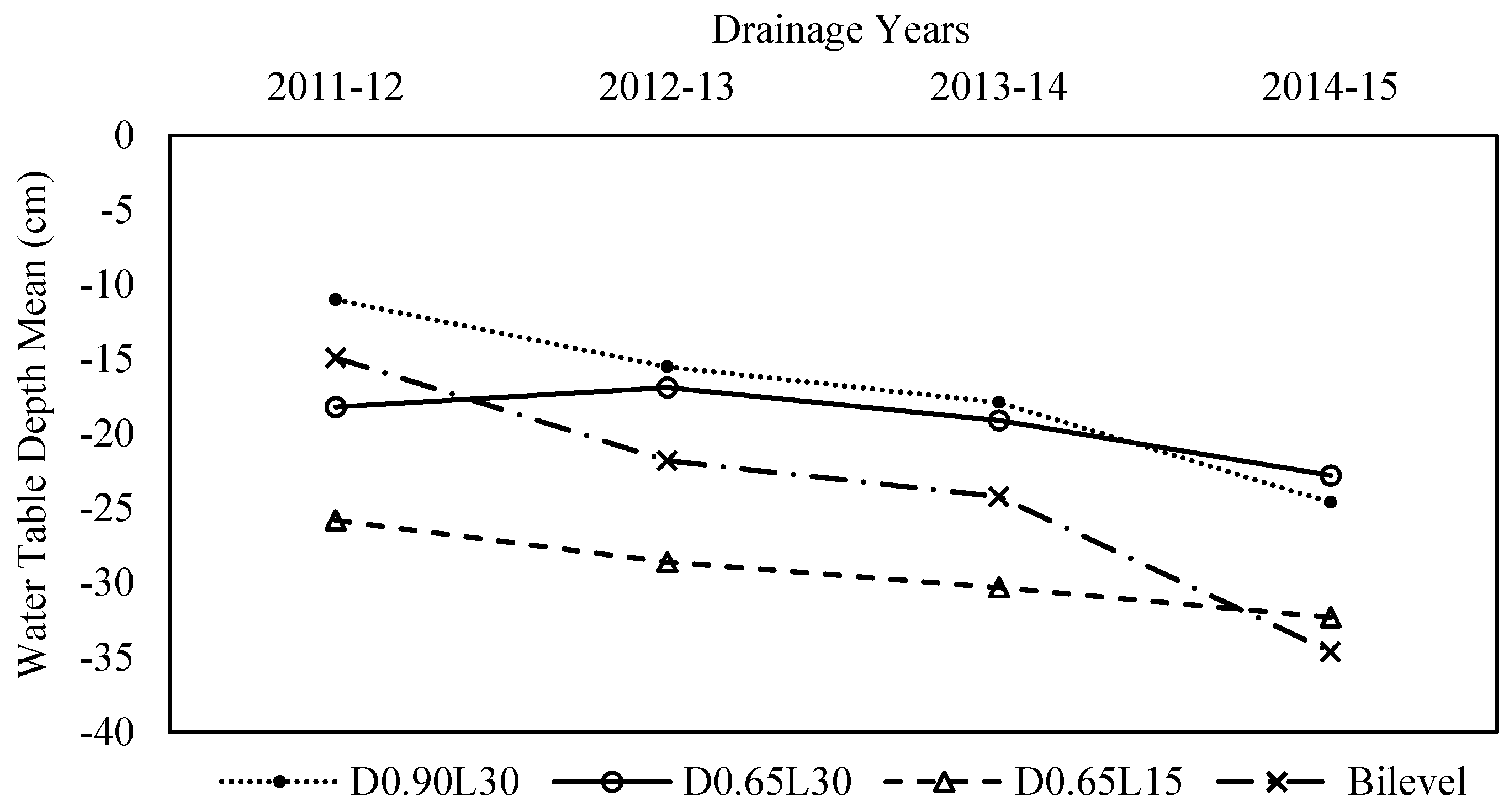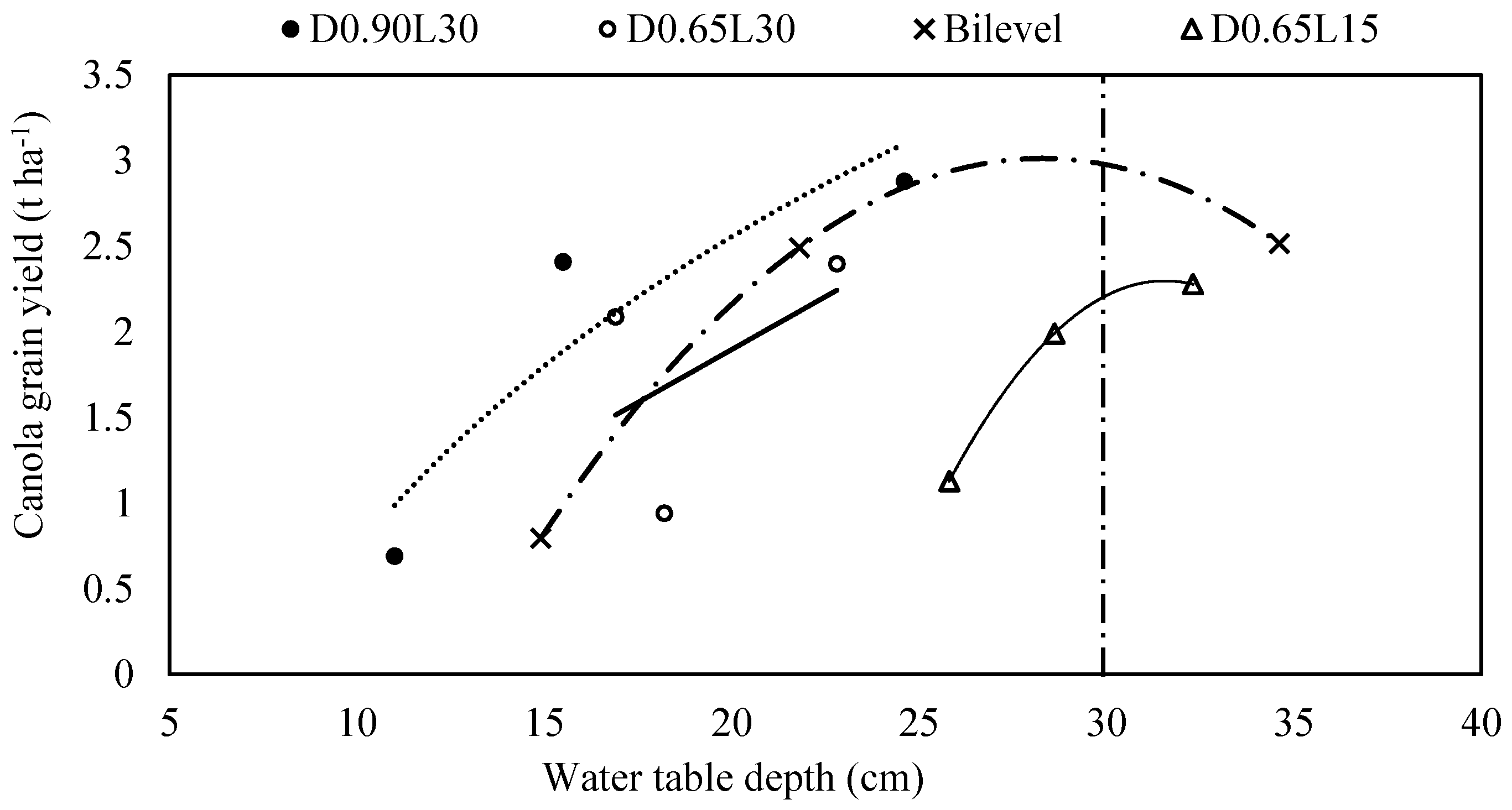3.1. Long-Term Effects of Subsurface Drainage Systems on Saturated Hydraulic Conductivity
Saturated hydraulic conductivity is one of the most important indicators in the irrigation and drainage of water management of paddy fields [
29]. The K
s means in different soil layers before the drain installation with the
t-test statistical analysis results are presented in
Table 4. There were significant differences among K
s values of soil layers. The surface soil had the highest K
s, 32%–234% higher than that of other layers. Same as our result, higher permeability in surface soil layers than other ones in Vietnamese paddy fields was reported [
30]. The more permeable the surface soil is, the more easily water can infiltrate after the flooded period. Also, in subsurface drained paddy fields, the flow pattern to drains can be under the control of surface soil permeability as water flows horizontally to backfilled trench [
24] in a narrow surface soil and then vertically flows into drains. Under the surface layer, there is a low-permeability layer that has major effect on the water regime in paddy fields. The K
s of the 60–90 cm soil layer, where the drains were placed, was lower than that of surface soil; however, it was higher than that of other layers in providing better conditions for draining excess water coming from above and below the drain level.
The comparison between
Ks values measured before and four years after drain installation are presented in
Table 5. There were significant differences between K
s in upper layers. Four years following installation, the
Ks of soil layers (especially surface layer) increased. In one study [
19], it was indicated that the installation of subsurface drains greatly increased the K
s. The hydraulic conductivity of clayey soil is low, although during the drainage period, clays shrink and cracks begin to form at the surface, which extend deeper in the soil as the soil dries out [
31], resulting in an increase in K
s.
The K
s of the top 0–30 cm of surface layer has increased more than the other layers. In general, paddy soil fluctuates seasonally between submergence and drainage conditions, depending on water management. When soil drains freely, aeration condition improves, especially in the surface layer. But for subsoil layers, it takes a long time to crack [
32] because soil under the drain depth is often saturated.
The K
s in different soil layers at the experimental site is given in
Table 6. These amounts are related to before the installation of subsurface drainage systems and four years after that in different treatments. Before the drain installation, K
s ranged from 0.075 to 0.287 m·day
−1 in different soil layers. This range is the same as the K
s values generalized for poorly-structured clay loam and clay soils [
33]. The K
s of the surface soil layer increased by 172, 212, 289, and 293% in D
0.65L
30, D
0.90L
30, Bi-level, and D
0.65L
15 treatments, respectively, as a result of improved soil condition due to wetting and draining processes. In a paddy field study, increasing K
s from 0.144 m·day
−1 to 1.5 m·day
−1 (940%) was reported before installation of drainage systems and 10 years after installation, respectively [
34]. More draining and cracking by dense drains (D
0.65L
15 and Bi-level) caused more increases in K
s in comparison with other treatments. Such increases were not observed in soil layers below drain level in any treatment.
The K
s values calculated by the Glover–Dumm equation are presented in
Table 7. These values were calculated by using water table height and corresponding drain discharge in the fourth season, assuming a homogeneous soil profile. The average calculated K
s values and horizontal mean (the sum of the product of the K
s and thickness of the various layers on whole thickness of layers) of measured K
s in different layers are presented in
Table 8. There was no significant difference between measured and calculated K
s values in different drainage treatments. Therefore, it can be concluded that the measured K
s values were a good representation of K
s in the study area and the drainage systems were designed well. In the Glover–Dumm equation, the relation between water table and drain discharge is linear (Equation (3)). In the presented drainage systems, the relationships between measured water table height and drain discharge were slightly linear. This indicated that flow condition nearly follows from the theory governing the Glover–Dumm equation. In D
0.65L
30 systems, a linear relationship between h
t and q
t was more visible than in other systems.
In D
0.65L
30, the average K
s calculated by Glover–Dumm is 15% higher than the measured one, and in D
0.90L
30 and D
0.65L
15, it is 25.7% and 32.4% less. The differences can be due to underestimation of the Glover–Dumm equation in computing drain spacing or other parameters. In two studies [
35,
36] for determination of subsurface drain spacing, the Glover–Dumm equation had a tendency to underestimate the drain spacing. Also, this equation resulted in −33.31% to −31.55% deviation from the actual spacing [
37].
3.2. Long-Term Effects of Subsurface Drainage Systems on Drain Discharge
Mean drain discharge in each growing season in different drainage systems are shown in
Figure 3. After this, the Bi-level-D and Bi-level-S are deep and shallow drains of the Bi-level system, respectively. In the first season, minimum and maximum drain discharges were 1.23 and 1.77 mm·day
−1 related to D
0.65L
30 and D
0.65L
15, respectively. By increasing the drain spacing, the rate of drain discharge decreased. The new installation of the drainage systems in the study area, heavy textured soil in the hardpan, and its low hydraulic conductivity [
38] are some of the reasons for low drainage volume in the treatments with higher spacing [
39]. Also, in the D
0.65L
15 treatment, shallower drain depth caused shorter time for water to reach drains. It was indicated that in clayey soils with dense structures in near-surface horizons, shallow subsurface drainage systems may be fundamental for rapid water flow out of the root zone [
40].
Mean discharge rates of the drainage systems have increased with time. In the third and fourth seasons, the discharges were higher than that in the first and second seasons. In the fourth season, the Bi-level-D system with 1.04 mm·day
−1 had the highest increase in discharge than the others. Improving the saturated hydraulic conductivity of surface layers has a direct relation with this change [
27]. Also, the drain discharges of Bi-level drainage systems in most seasons were higher than that of the other systems. This shows drainage was more effective in this plot and resulted in the greatest increase in K
s and the drains’ discharge rates. Also, because of alternative depths in the Bi-level system, which were placed at two different levels, it was helpful to make more cracks. Once cracks arise in the surface soil, water from rainfall flows rapidly into the underdrains through the cracks [
32]. In another result, higher discharge in Bi-level-D than Bi-level-S was observed in the present study. This demonstrated that with improved soil conditions, a deep drain discharged a greater volume of excess water than a shallow drain.
Also, due to larger area under drainage with 30 m spaced drains (D
0.65L
30 and D
0.90L
30), the discharge rates of those were less than closer-spaced drains. It was demonstrated with a two-dimensional drainage model that drain discharge is inversely and nonlinearly related to drain spacing across a range of spacings from 5 to 50 m [
41]. In the second season, the discharge rate in the D
0.65L
15 system was lower than other seasons. This could be due to shallow depth of drain, more surface runoff, and dense soil structure.
The variation of daily drain discharge during five days after initial water table occurring (raised up to surface) in each growing season for different drainage systems are presented in
Figure 4,
Figure 5,
Figure 6,
Figure 7 and
Figure 8. The drain discharges in first day for D
0.90L
30 were the highest in the fourth season and the lowest in the first season (
Figure 4). During the first season, the drain discharge decreased gradually in later days. By the seasons, the rate of drain discharge improved and the slope of the represented line increased. This means that more excess water was drained during the first and second days after rainfall. Increase in saturated hydraulic conductivity caused an increase in drain discharge in the first and second days, that can be more effective in draining excess rainfall and protects crop from waterlogging stress.
In the D
0.65L
30 treatment, as shown in
Figure 5, the highest and lowest discharge rate in the first day were 2.59 and 1.47 mm·day
−1, related to the fourth and first season, respectively. Due to shallow depth and wide spacing and small variation in saturated hydraulic conductivity (
Table 6), the drain discharge rates had no major differences and varied gradually. Also, based on considerable variation in discharges from the fourth year, it can be implied that an increase in saturated hydraulic conductivity in this treatment has started after three years.
In the D
0.65L
15 treatment (
Figure 6), the daily discharge rates decreased quickly. Due to close spacing and also shallow depth with smaller effect of hardpan layer, more excess water was discharged during the first and second days. Depth and spacing of drains as design parameters of a drainage system influence the amount of water entering drains from both saturated and unsaturated regions [
39]. Also, increasing in drain discharge by the seasons was done gradually and resulted in constantly increasing saturated hydraulic conductivity.
In Bi-level-S as shallow drain (
Figure 7), the differences among discharges were less in comparison with Bi-level-D as deep drain (
Figure 8). Furthermore, by improving the performance of drains and soil hydraulic conditions since the third and fourth seasons, both drain lines have discharged more excess water in the first day. Actually, two years after drain installation, improvement in soil condition and drain discharge was observed in this treatment.
In
Table 9, the differences between drain discharges of the first and 5th days in different drainage systems along with related water tables for each year are presented. The highest value of differences was observed in the fourth season (2014–2015). The monitoring programs during the four years after the installation of the subsurface drainage systems clearly show that the subsurface drainage systems increased the drain discharge of the first day, although there were differences between the treatments. In the D
0.90L
30 and D
0.65L
15 treatments, increases in drain discharge over the years were gradual, but in the D
0.65L
30 and Bi-level treatments, considerable increases in drain discharge were observed from third and fourth years, respectively. It can be concluded that the differences in drain discharges are influenced by soil condition improvement. Also, in the fourth year, deep drains (D
0.90L
30 and Bi-level-D) had the highest difference between daily drain discharges, because they discharged most of the excess water during the first days. A study [
42] found that a deep drain pipe resulted in higher tile flow. The present research has also shown that soil properties can influence tile hydrology. The plow sole layer plays a major buffering role for water flow during both dry and wet seasons [
43]. However, by the time of soil structure improvement, better operation from drains can be observed.
3.3. Long-Term Effects of Subsurface Drainage Systems on Water Table Depth
Fluctuation of the water table due to the effect of subsurface drain depth and spacing was also studied. The mean water table depth for each treatment over the seasons are presented in
Figure 9. Drain systems with narrow spacing (D
0.65L
15) had lower water table depth than wider spacing (D
0.65L
30). In assessing the impacts of subsurface drainage on water table depth in northwest Minnesota, drainage systems with 12 m spacing were more effective than that with 24 m spacing [
44], which is the same as the result of the present study. Moreover, due to heavy soil in paddy fields and the existence of hardpan layer [
22], the performance of shallow drains in lowering the water table was better in the first season. Deeper drains do not necessarily result in a lower water table [
7].
Generally, the mean water tables became deeper from year to year. However, decrease in water table depth for D0.65L30 in the second year in comparison with other years could be due to high rainfall during this season (599 mm). By improving the soil conditions for water movement and also increasing drain discharges, the performance of deep drainage systems (Bi-level and D0.90L30) improved. The highest increases in water table depth during the four seasons happened in the Bi-level drainage system with an increase of 19.7 cm. Finally, in the fourth season, deep drainage systems had better performance in draining excess water with respect to shallow drainage systems. Since the water table in the D0.90L30 treatment was deeper than in D0.65L30.
Table 10 presents the differences among the water table depths at the fourth year and also for the whole study period. The shallowest water table depth in the fourth year was related to D
0.65L
30. In the Bi-level system, the water table dropped more than others and it was 52% deeper than D
0.65L
30. The drop in water table depth of D
0.90L
30 was also 8% more than D
0.65L
30. This was because of improving soil condition and movement of water to lower layers. Moreover, during the study period, the D
0.90L
30 and D
0.65L
15 had the lowest and deepest water table depth, respectively. Heavy soil texture and low hydraulic conductivity during the first years were the reasons for low fall in water table in deep drains.
3.4. Long-Term Effects of Subsurface Drainage Systems on Canola Yield
The statistical analysis results of canola yields under subsurface drainage systems are shown in
Table 11 and
Table 12. Canola yields from the subsurface drainage treatments were from 450 kg·ha
−1 to 3119 kg·ha
−1, respectively, for the first and fourth seasons extending from 2011–2012 to 2014–2015. Due to waterlogging, it was not cultivated before drainage. In India, increase in crop yield after 2 or 3 years of drain installation were observed from 1400 to 2800 kg·ha
−1 for wheat [
15]. In the second season, grain yield increased in all treatments.
Table 11 demonstrates that in the subsurface drainage plots, the yield gaps between the seasons were significant. The average grain yield increased from the first to second seasons and the second to fourth seasons by 152% and 12%, respectively (
Table 12). In a similar study at Chashma Command Area Development Project of Pakistan during 2001–2004, quantitative comparison of pre- and post-project conditions of drainage revealed that crop yield increased for cotton (80%), sugarcane (94%), wheat (67%), and chili (147%) [
45]. Increases in canola grain yield were obtained because of improvement in water table depth and drain discharge. As shown in
Table 12, the water table depths in the fourth year were deeper than that in other years. Also, increase in canola yield from second year to fourth year can probably be related to fertilizer application.
Average yields obtained under subsurface drainage systems were noticeably significant when compared with each other (
Table 11). In the first season, the D
0.65L
15 system had the highest grain yield because of better performance in discharge and falling water table (
Table 12), but it was lower than the result of Cannel and Belford [
46]. They harvested grain yield of oilseed rape (
Brassica napus L.) as much as 3.26 t/ha in freely drainage treatment. One of the reasons for low yield is waterlogging (30 days the water table depth was less than 30 cm, as shown in
Table 13) or shallow mean of water table (
Table 12). In evaluations, a high reduction (14%–23%) in canola yield (rapeseed) was observed with a prolonged period of waterlogging, especially during winter [
46,
47]. In the second and fourth seasons, the canola under the Bi-level and D
0.90L
30 treatments had the highest grain yield, respectively. Also, there were significant differences between the D
0.90L
30 and Bi-level or D
0.65L
15 treatments in the fourth season. In a long-term study [
48] to measure corn grain yield as affected by subsurface drain spacing, three drain spacings (5, 10, and 20 m) were compared. The results demonstrate that significant distance effects occurred more frequently for the 20 m spacing than for the 10 and 5 m spacings. Meanwhile, the yield under drainage systems with deeper depth (D
0.90L
30) were higher in the 2nd and 4th years as compared with the treatments with shallow drains (D
0.65L
30). This was because of more fall in water table levels during these seasons and also less number of days that the water table depth was less than 30 cm (
Table 13).
Figure 10 shows the canola grain yield in response to average of water table depth for different treatments during the study period to establish a relation between crop yield and the water table. In all treatments, the water table lowered after the introduction of subsurface drainage and crop yields increased significantly. However, the low water table may influence soil aeration, nutrient availability, and plant available moisture, but the net effect on plant growth will vary widely with crop type [
49]. In this pilot, canola was harvested with yield maximum 3.1 t·ha
−1, which is close to some reported values in the literature. The Canola Council of Canada [
50] represented the highest canola yield of different varieties with 3.29 t·ha
−1. Also, in a study in Australia, canola (
Brassica napus) yields were 3–3.5 t·ha
−1 and close to potential estimated [
41]. So, the crop yield data analysis revealed that the objectives of drainage systems installation have been closely achieved in terms of improving the crop yields and maximum potential yield.
Basically, by lowering water table depth to optimum depth, the grain yield increases and the average of water table depth was plotted direct the average yield. Lower than optimum depth, this decreases due to much more drying and excessive drainage. By lowering water table depth to 30 cm, the grain yield of canola increased. The roots of canola are more distributed at 0–40 cm depth [
51]. However, lower than 30 cm this declined, based on the results of the D
0.65L
15 and Bi-level treatments. Canola suffered a decrease in yield when the average water table dropped to 35 cm below the soil surface. So, it seems that average water table depth of 30 cm is optimum depth. Optimum growing conditions for canola in the area required that the water table midway between the drains would have an average depth of 30 cm. This depth is also suitable for ploughing. Therefore, the SEW
30 can also be a good index for waterlogging stress. On the other hand, the D
0.90L
30 treatment had a direct relation between canola yield and water table depth, so this treatment needs more draining and improvement in soil condition, and can yield as much as the potential expected in future. However, in the D
0.65L
30 treatment, it is roughly possible to draw a direct relation between water table depth and canola yield.
Subsurface pipe drainage removes excess soil water to keep the soil moisture favorable for crop growth. From the performance point of view of drainage system operation, crop yields are generally expected to increase with the installation of subsurface drainage system [
45]. Generally, canola yield as second cultivation has increased from the first to fourth seasons and along with improvement of soil aeration conditions and performance of drainage systems. The results showed direct relationship between improvement of system performance and increasing in grain yield. Moreover, improvement of soil structure and more yield after the operation will be followed by a rise in the economic level. An economic analysis showed that the cost of installing subsurface drainage systems was readily justified by annual increased rice and canola yields [
9]. Also, quantifying the influence of these treatments on the salinity of drainage water indicated that by increasing drain spacing, the electrical conductivity (EC) and total salt load decreased [
39]. Therefore, the D
0.90L
30 treatment from environmental and economical points of view have also had suitable conditions.

 location of observation well, and
location of observation well, and  point of drain flow measurement). D0.65L15: 0.65 m depth and 15 m spacing, D0.65L30: 0.65 m depth and 30 m spacing, Bi-level: four drains of 15 m spacing with depths of 0.90 m and 0.65 m as alternate depths, D0.90L30: 0.90 m depth and 30 m spacing.
point of drain flow measurement). D0.65L15: 0.65 m depth and 15 m spacing, D0.65L30: 0.65 m depth and 30 m spacing, Bi-level: four drains of 15 m spacing with depths of 0.90 m and 0.65 m as alternate depths, D0.90L30: 0.90 m depth and 30 m spacing.
 location of observation well, and
location of observation well, and  point of drain flow measurement). D0.65L15: 0.65 m depth and 15 m spacing, D0.65L30: 0.65 m depth and 30 m spacing, Bi-level: four drains of 15 m spacing with depths of 0.90 m and 0.65 m as alternate depths, D0.90L30: 0.90 m depth and 30 m spacing.
point of drain flow measurement). D0.65L15: 0.65 m depth and 15 m spacing, D0.65L30: 0.65 m depth and 30 m spacing, Bi-level: four drains of 15 m spacing with depths of 0.90 m and 0.65 m as alternate depths, D0.90L30: 0.90 m depth and 30 m spacing.














